Should I Continue to Use the Starter Bottle
Your sourdough starter is a mixture of yeast and bacteria (the right kind) that co-exist to leaven bread naturally, add complex flavors, and aid nutrient absorption: it's no wonder it quickly becomes part of your family. I've been maintaining mine for many years now, regularly refreshing it twice a day, every day, and the process is so familiar I don't even think about it anymore. But it's nothing mystical or magical, my sourdough starter is a culture I give nourishment (flour and water), and in return, it happily does work for me without even realizing it. But many uncertainties can arise along with its maintenance, and this frequently asked sourdough starter questions post is here to help.
I've been compiling this list of frequently asked sourdough starter questions for almost as long as this website has been around. Each time I receive an email or comment asking a question about what I do in a particular situation, I've saved it away and have added the most commonly asked questions below.
If you've arrived here before you have a starter of your own, it might be worthwhile to have a read through to internalize some of these questions and answers. Then head to my guide to creating a sourdough starter and get started.
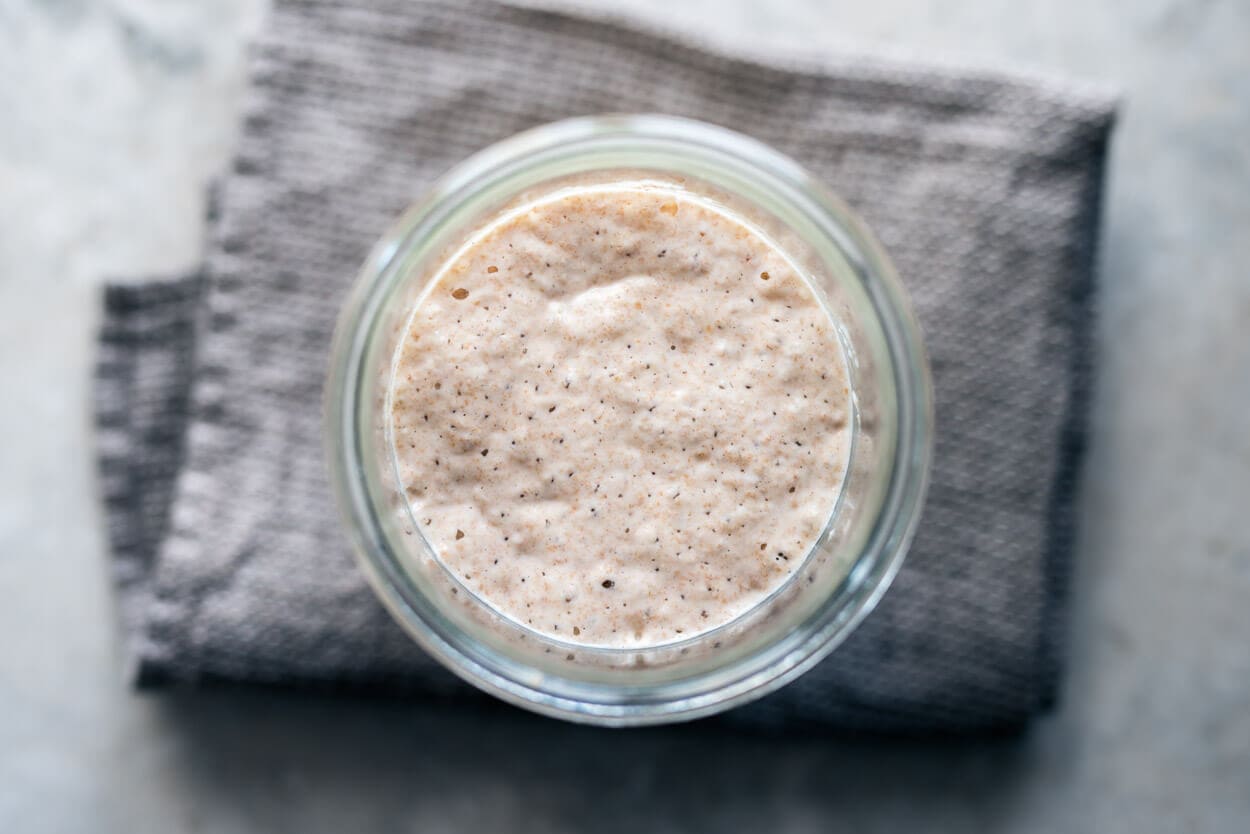
Frequently Asked Sourdough Starter Questions
-
How do I create a sourdough starter?
-
In your starter guide you say to use whole grain rye flour, can I use something else?
I call for whole-grain rye flour when creating a starter because the additional nutrients in rye flour help speed up the process. You can certainly use whole wheat flour or even white (sifted) flour if you'd like, but I find rye flour to be the most effective flour at the beginning. If you don't have rye flour, then whole wheat works!
-
My starter died! It had lots of activity early on, but now it seems dead, what happened?
It's normal to see a lapse of activity at some point when first creating a sourdough starter—this is normal. The initial proliferation of action at the beginning of creating a starter is from a different type of bacteria in your mixture that will eventually be replaced by the kind we are looking for (lactic acid bacteria). Keep feeding, and discarding, as I outline in my creation guide. Eventually, your mixture will slowly become more and more acidic (low pH), killing off other bacteria and allow the beneficial yeast and bacteria we are looking for to take hold.
-
I've been following your starter creation guide, but nothing is happening, what's wrong?
The number one problem I see people face is low temperature: it's easier to create your starter if you keep it at a warmer temperature. Cold temperatures (below 70°F/21°C) will slow the process down significantly, whereas warmer temperatures (around 76-82°F/24-26°C) will speed it up. Try to find a warm spot in your kitchen to keep your starter or use more lukewarm water for feeding. For more information on starter and dough temperatures, see my post on the importance of dough temperature.
-
When creating a starter your guide says to "cover the mixture," should that be airtight?
It doesn't have to be, no. I loosely place a glass lid on top (as you can see in the pictures on this page), but it's not sealed shut. You want to cover it mostly to prevent anything from inadvertently falling inside the jar, but it also helps prevent the mixture from drying out.
-
When is my starter strong enough and ready to bake with?
Once you see predictable signs of fermentation (rise, bubbles, a transformation in aroma from sweet to sour, etc.) each day, it should be strong enough for baking. When creating a starter from scratch you might see a spur of activity at the beginning of the process, but you want consistent signs of fermentation day after day before it's strong enough to use for leavening. Typically, when creating a new starter, this is after 5-8 days.
-
What is the difference between a "starter" and a "levain (leaven)"?
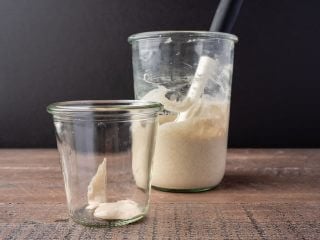
Confusingly, these terms are sometimes used interchangeably by bakers, but I'll define them how I learned them, and how I use them here at my website.
A starter goes by a few names (mother, chef, etc.) but mainly it's an ongoing culture that's always fed and never wholly used in any given bake. This culture is supplied with flour and water at some period (preferably daily) to maintain strength, so it's ready to build a levain, which is consumed in a single bake.
By contrast, alevain3 is a small offshoot of your mother starter, an intermediate mixture that eventually "dies" when baked in the oven. Your levain is "built" using a small portion of your starter that is fed with flour and water and left to ferment for some number of hours. Once this levain is ready (has undergone sufficient fermentation) the amount called for in a single recipe is used to mix with the rest of the flour, water, and salt for a specific bake. -
Do I have to build a levain or can I use part of my sourdough starter?
It's always an option to use your starter instead of making a levain. But, for most recipes, I prefer making a levain so I can control the flour going into the levain, the ripening timeline, and when I use it to mix into a dough—all of this without having to adjust my continually maintained sourdough starter.
For example, I might use my levain a little on the early ("young") side when mixing into a white flour enriched dough, like cinnamon rolls, to avoid using an overly active, acidic levain which might bring more sourness in the end. -
What kind of container should I use for my sourdough starter?
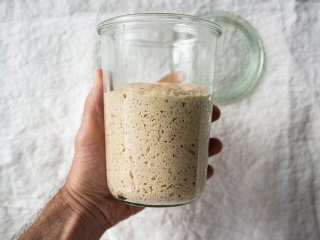
You can use just about anything. I like to use clear glass containers so I can observe the sides and bottom and these Weck jars are my favorite. They have a glass lid that rests on top just in case too much pressure builds up inside the jar from fermentation. Canning glass jars are also a perfect choice.
-
How often do you change or clean your sourdough starter container?
Use the same jar each day and try to keep it as clean as possible. During a feeding, discard part of your starter per usual and then scrape down as much of the residual starter as you can, reincorporating it back into the mixture. Then wipe the top and sides of the jar with a towel to remove any remaining liquid. If you can get the top half reasonably clean that's good enough, the bottom half of the jar will most likely be covered when your starter rises during the day anyway.
-
What kind of water should I use to feed my sourdough starter?
Regular drinking water from the tap is just fine. Fill up a large container (I have a 40oz stainless steel water bottle I always keep filled for baking) and let it sit on the counter overnight before using to allow any chlorine in your tap water to dissipate.
-
What kind of flour should I use to feed my sourdough starter?

When creating a starter from scratch, I like to use whole grain rye flour to get the starter established — the extra nutrients in whole rye flour help speed up the process. After your starter is rising and falling predictably, you can change over to any flour combination you'd like throughout a few feedings.
That said you can certainly use any combination of flour you'd like: whole wheat, white wheat, white whole wheat, rye, spelt, etc. Just note that I find rye to be almost a failsafe flour to get your starter going! -
I hate throwing away excess sourdough starter after feeding, what can I do with the discard?
Cook or bake with it! There are many things you can sneak leftover starter into: banana bread, waffles, pancakes, tea cakes, muffins, pizza, cookies, and so on. My post on my three favorite leftover sourdough starter foods is a great place to start! If you want to use less flour overall, check out my guide to maintaining a smaller sourdough starter. Aside from using the discard in other foods, I will almost always compost any leftover, only using the trash as a last resort.
-
Can I refrigerate my sourdough starter?
I have successfully refrigerated my starter many times, typically when I'm going to be out of town on vacation for a few weeks or won't be baking for a while (rare!). To prepare for the fridge, I will wait until the starter needs a refreshment, discard all but 20g of mature starter, and then refresh it with 100g flour and 80g water (I like the culture to be a bit on the stiff/dry side). After refreshing, let it sit out on the counter for 1 hour or so, then toss it into the fridge. I will usually use the same Weck jars for this, and the cover will be loosely placed on top so nothing can fall in, but excess gasses can escape.
When I want to bake again, I will remove my starter from the fridge, let it ferment on the counter for a few hours, and then feed it as I would normally. I will do this a few days before I plan to bake to get the culture back up to strength.
See my post on storing a sourdough starter for tips on keeping it in the fridge or other methods for longer periods. -
Why doesn't the sourdough starter float test work?
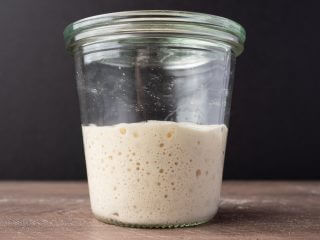
The float test is a good general indicator for when a starter or levain has significant fermentation, but I find it is not 100% reliable in testing for when a starter is ready for use. It can lead to false positives, but, as I discuss below, when your starter makeup is not with a majority of white flour at a moderate to high hydration, it will also rarely float even if your starter is ripe. Instead of using the float test, I like to look for the signs of strong fermentation and ripeness.
-
What is a Ripe (or Mature) Starter?
I often say "ripe" or "mature" to mean when my starter begins showing signs of readiness for the recipe at hand. Typically, this means lots of visible bubbles, some rise in the jar (I find the amount of rise is not as important because it depends on your starter's makeup!), a sour aroma, and a general breakdown and loosening of the consistency. You can see all these signs in the image of my starter, above.
For a liquid starter (typically 75% hydration and above) you'll see lots of bubbles and aeration and the mixture will be loose, and if you gently pull back the top layer, or give it a stir, you'll feel how the mixture has broken down.
For a stiff starter ( usually around 65% hydration or below) maturity usually shows when the dome at the top of the starter just begins to collapse and recede. After first mixing a stiff starter and forming it into a ball, it'll relax out to fill the jar and start to rise up, forming a dome. When mature, the dome will look less like the top of a ball and more like a plateau. Additionally, the top will show a soft and crackled texture, it will look like it's breaking apart, and if you pull back this top, you'll smell a pungent sour aroma and the entire mixture will have softened. -
My starter doesn't seem as strong as yours (fewer bubbles, slow rise, etc.), what's wrong?
If you've only just created your starter give it some time to mature. With consistent, predictable refreshments, you will "train" your starter into strength and it will display the same signs of strong fermentation each day.
Temperature is also incredibly important here: keeping your starter relatively warm (I prefer 76-80°F/24-26°C) will encourage increased activity. -
My sourdough starter takes a long time to ripen, how come?
Several factors play into the fermentation vigor of your starter, and the most important one is temperature. Try to find a warm spot in your kitchen to keep your starter or use more lukewarm water to feed it. Shoot for 76°F – 80°F (24-26°C) ambient temperature for increased fermentation activity. Maintaining a stable temperature is important, and if there's one thing I like to focus on with my starter, it's temperature.
Flour selection plays into the fermentation activity as well, the more whole grains you use to refresh, the higher the fermentation rate in your culture.
And of course, the amount of mature starter you carryover from feeding-to-feeding plays a significant role. The larger the percentage, the faster your newly refreshed culture will ripen.
All of these variables can be tweaked to speed up, or slow down, the time it takes for your starter to ripen and need a refreshment. My preferred method for changing my starter's ripening timeline is to adjust the amount of starter I leave in the jar each refreshment (the carryover). If it's summertime, I will usually carry over a smaller percentage of ripe starter (15% or so) at each refreshment to slow things down so I can maintain my twice a day refreshment schedule. If it's winter and temperatures are lower, I'll carry over an increased amount of mature starter (25% or so) into my next refreshment. -
How many times should I feed my sourdough starter each day?
This question is very temperature and flour dependent. If the ambient temperature in your kitchen is on the warmer side, 75-80°F (23-26°C), then you'll find your starter ferments much faster than if it were cooler (< 75°F/23°C). Likewise, if you're using a large percentage of whole grains in your refreshment, you'll see higher fermentation rates.
I prefer to feed my starter two times per day to keep it healthy and ready to bake with at any moment. But then again, I bake very, very frequently. If temperatures are not overly high a single feeding per day is what I recommend. If you find your starter falls significantly in its jar, looks very broken down and loose, smells like harsh vinegar or paint, try using a smaller percentage of mature starter at each feeding. You can also find a cooler spot in your kitchen or use colder water to feed.
For example, in the summer (typically 75-78°F/23-26°C in my kitchen) I will feed my starter twice a day, but even then I have to reduce my mature starter carryover percentage. Instead of my usual 20-25% in the winter, I drop it down to 10-15% and find a shaded, cool spot in my kitchen to slow things down.
For more information on this, including pictures, see my post on maintaining your sourdough starter. -
How can I adjust my sourdough starter feeding schedule around my work schedule?
For a very in-depth discussion on how to maintain your starter in the fridge during the week and use it to bake on the weekend, head over to my Weekend Baking Schedule guide! Additionally, see the previous question for what "tools" you can utilize to speed up, or slow down, the fermentation rate of your starter.
-
Can my sourdough starter be above (or below) 100% hydration?
Of course. When it's significantly hot and dry here in the summer, and the flour seems to need a bit more water, I'll increase my hydration to 105% or higher as required. You can adjust the amount of water you use at each refreshment, so the mixture displays the desired viscosity. As the humidity level in your environment changes, adjust the hydration up and down 5% to compensate.
-
My sourdough starter gets a clear, thin liquid that smells like alcohol on top, should I throw it out?
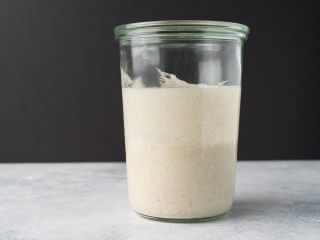
You can discard this liquid (or "hooch" as it's commonly called) or stir it back down into the culture, either way. I typically stir it all in together.
-
The "float test" never works with my stiff sourdough starter, what gives?
When the hydration of your starter or levain is sufficiently low, the "float test"4 becomes less accurate, and in most cases, doesn't ever pass.
Instead of using the float test, observe the actual culture and how it's progressing. You want to see a slightly domed top to the levain with lots and lots of bubbles at the sides (see the picture before this section). If you peel back the top, you'll see and smell significant fermentative activity. These are signs that your levain is mature enough to use in your final dough mix. -
How does high altitude affect my sourdough starter?
You might see increased fermentation activity at high elevations. See my baking at high altitude guide for more tips.
What's Next?
If you're having issues with your sourdough starter and haven't found help above, post at our member community for help!
For more things starter-related, have a look at the following posts to maintain your starter, store it for the long term, and then get baking!
- Check out my current sourdough starter feeding ratios (flour, water, ripe starter carryover)
- My sourdough starter maintenance routine to keep it strong and healthy
- How to store your sourdough starter when not in use
- Make a sourdough starter discard recipe (waffles, pancakes, and more)
- Twenty-one of the most common sourdough starter problems (with solutions)
Is there any frequently asked sourdough starter question I missed? If so, please comment below!
Happy baking!
dorrishinnelaming.blogspot.com
Source: https://www.theperfectloaf.com/frequently-asked-sourdough-starter-questions/
0 Response to "Should I Continue to Use the Starter Bottle"
Post a Comment